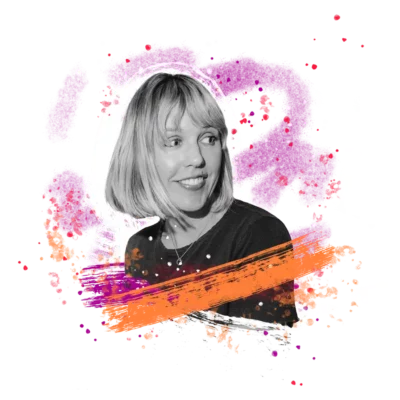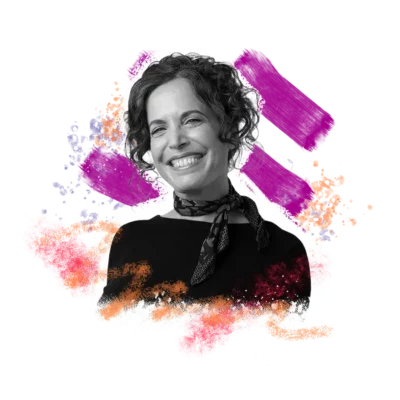Always be iterating
Nataly Dawn and Jack Conte started the band Pomplamoose together in 2008. The band found success with their viral YouTube videos, which have hundreds of millions of views. And while we usually tell the story of a single work on this show, in this episode, Jack and Nataly share the story of the band itself. The story of Pomplamoose is one of constant iteration, which is a skill any creative can take into their own practice. As Nataly and Jack take you through the journey of Pomplamoose, you’ll hear how — through years of starts, stops, and iterations – they adapt what they make and how they make it so they’re able to keep creating — with everything life throws at them. You’ll see that in order to keep creating, you have to continually adapt your work to the conditions of your life.
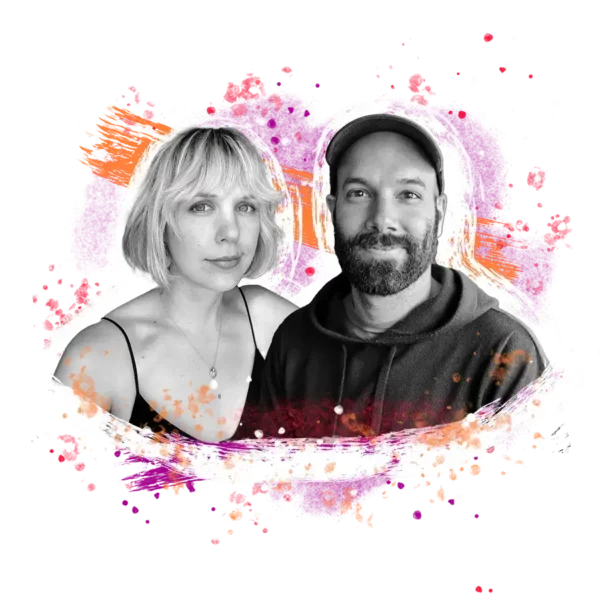
Transcript
Table of Contents:
- Chapter 1: What’s the problem?
- Chapter 2: The spark
- Chapter 3: I guess we’ll risk it
- Chapter 4: The rules of the video song
- Chapter 5: We start recording
- Chapter 6: A cover song goes viral
- Chapter 7: How dare you
- Chapter 8: The best night of my life
- Chapter 9: We need a break
- Chapter 10: Pomplamoose returns — for Season 2
- Chapter 11: We discover the mashup
- Chapter 12: Making the video for “Happy Get Lucky”
- Chapter 13: Something has to change
- Chapter 14: Pomplamoose, Phase 3
- Chapter 15: It’s a new thing now
- Chapter 16: What is Pomplamoose anyway?
Transcript:
Always be iterating
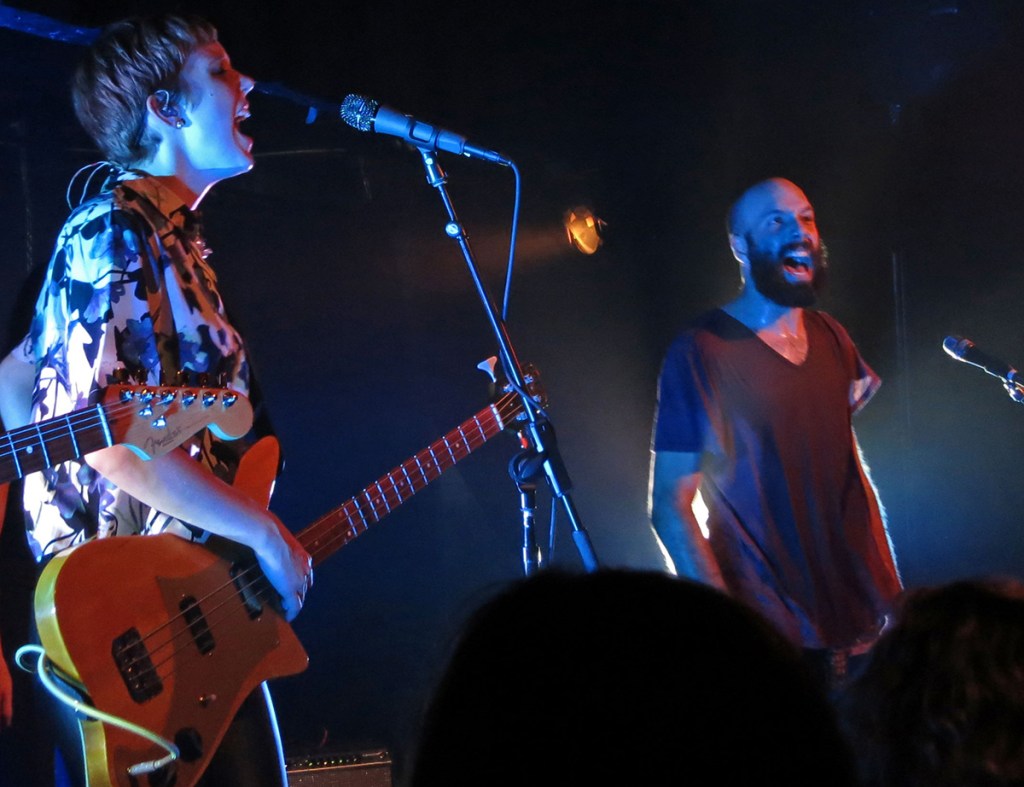
Nataly Dawn and Jack Conte of Pomplamoose play the Black Cat in Washington, DC, in 2014. Photo by Joe Loong; see more on Flickr.
Chapter 1: What’s the problem?
NATALY DAWN: Just like night after night after night of shows. And the whole day in the van, you were on your laptop and taking calls and running Patreon. And it was just so much; it was too much.
JACK CONTE: It was too much.
NATALY DAWN: And so we were really like.
JACK CONTE: That’s not working.
NATALY DAWN: It was not working.
Every time we take a break from Pomplamoose, it’s because we’re overwhelmed. It just takes a lot of time and experience to realize that you don’t need to stop everything. You feel like you need to because the feeling is overwhelming. Just ask yourself: why am I having this feeling?
JACK CONTE: Is the problem that we’re tired? Is the problem that we don’t have enough hours? Is the problem that we only have one day?
NATALY DAWN: Figure out what the specific things are that are overwhelming you. And you can address those things without giving up.
JUNE COHEN: That was Nataly Dawn and Jack Conte, a pair of musicians who also happen to be married. And they’re about to share the story of creating and sustaining their band, Pomplamoose.
Pomplamoose is probably best known for their viral YouTube music videos. And while we usually tell the story of a single work on this show, Jack and Nataly will tell us the story of the band itself.
It’s a specific story about two creatives and their band, which went through iteration after iteration to remain a YouTube sensation. But the takeaway is universal: in order to keep creating, you have to continually adapt your work to match the conditions of your life. Create, and iterate. Create, and iterate. Over and over.
As Nataly and Jack take you through the journey of Pomplamoose, you’ll hear how — through years of starts, stops, and iterations — they adapt what they make and how they make it so they’re able to keep creating with everything life throws at them.
They’ll share with amazing vulnerability how their personal lives affect their creative lives, and vice versa. And you’ll learn about when they decide to take a break — and how they start a new chapter.
And here’s what else you need to know about Pomplamoose. Nataly and Jack started Pomplamoose together in 2008. The band found success with their YouTube videos, which have hundreds of millions of views. In 2020, Pomplamoose won the Shorty Award for best YouTube Musician.
In addition to Pomplamoose, Nataly has released four studio albums as a solo artist. And Jack is also the co-founder and CEO of the tech company Patreon.
There are three distinct phases of Pomplamoose’s creative journey, which you’ll hear in this story.
Phase 1: The video song. In their first phase, they create a stripped-down way of making music videos — with strict rules to show exactly how the music is created.
Phase 2: The music video. Here they throw out all their old rules, and amp up innovation and production.
Then Phase 3: The company. Where they bring an entire team around them at Pomplamoose, so they can keep making music as their lives continue to change.
I’m your host June Cohen, and on this episode, you’ll hear original music composed for piano. For visuals while you’re listening, go to sparkandfire.com.
[THEME MUSIC]
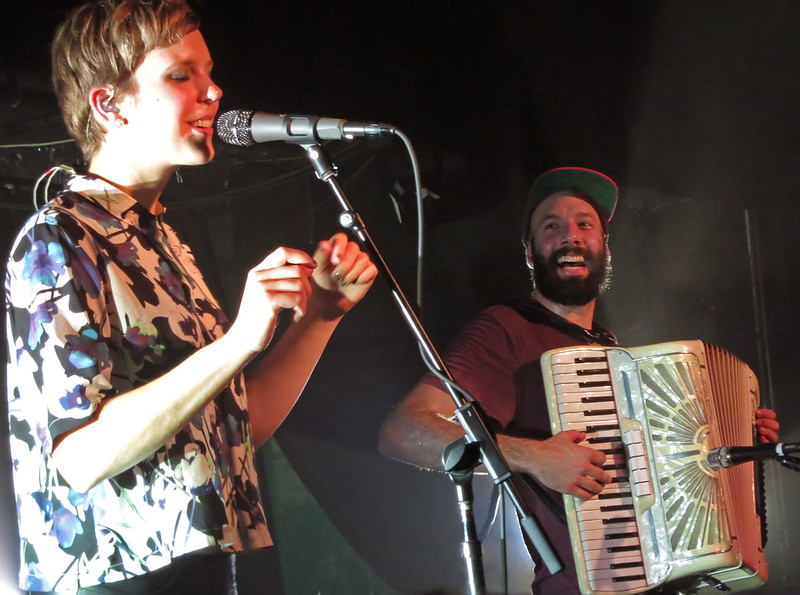
Nataly Dawn and Jack Conte of Pomplamoose play the Black Cat in Washington, DC, in 2014. Photo by Joe Loong via Flickr.
Chapter 2: The spark
NATALY DAWN: The very first spark for us was a romantic spark.
JACK CONTE: Yeah. Maybe it’s just that I’ve told this story 10,000 times, or maybe it was actually as smoky and like a soft, close up lens as I really remember.
NATALY DAWN: He was a senior at Stanford. I was a freshman, and I had seen Jack performing at the Coho. Usually the Coho, you’re not really playing to an engaged captivated audience, but with him, he was up there. He was looping things. He was singing, he was playing guitar. He was playing the piano, and he had this packed group of mostly women sitting on the floor.
JACK CONTE: This is Nataly’s memory now. This is not my memory. I do not remember a sea of women watching me perform in the Coho.
NATALY DAWN: I remember seeing you and thinking, oh, there’s just no chance. I could never talk to that guy. And then at the very end, one of your best friends came up and announced that you’d gotten into USC film school. And I was like, well, there he goes, he’s gone. I’m never going to see this person again. And he doesn’t even know I exist. But then a few weeks later we were on the same bill. I was opening for Jack’s band, same location.
JACK CONTE: I walked into the Coho, holding these drums. I heard Nataly’s music before I saw her, these meandering bass melodies and these amazing contrapuntal vocal melodies playing together. And I remember thinking: who the hell is creating this sound?
NATALY DAWN: And he stopped. And our eyes locked.
JACK CONTE: I saw her on stage, and I was like, oh my God, she was wearing this leather coat. She had this long bass. It was like lightning-bolt attraction, 11 out of 10. I was, like, mesmerized. And I swear to God, time slowed down. And I tripped over something in the coffee house and went tumbling forward and dropped the drums.
NATALY DAWN: One of his lines to me was…
JACK CONTE: I went up to Nataly, and I said, “That was amazing. I want to hear your voice every day.” I am terrible with women. I asked Nataly, “Do you have an album?” Because I wanted to buy her album. And she said, “No.” And I said, “Do you want one?” And she said, “Yes.” And so I immediately, I was like, “Okay, let’s make this happen.”
Chapter 3: I guess we’ll risk it
What if your personal life complicates your creative life? Learn to iterate on both.
JACK CONTE: We started making music simultaneously with getting romantic with each other. And that’s hard.
NATALY DAWN: It’s just really hard. If you’re new at communicating things in a relationship to also be communicating creative preferences.
JACK CONTE: We were new romantic partners and trying to make music together, and it was too much all at once. And we ended up breaking up. Years later, we came back together.
NATALY DAWN: We were pretty reluctant to start a band together while we were dating. You produced a song I’d written that was partially in French, partially in English, “Pas Encore.” There was something about, I mean, our polarized sounds. My jazzy, weird baselines and soft singing with your expressive dynamic production — that when you brought them together, it made something special.
JACK CONTE: When we posted it, it was more popular than anything that I ever made and more popular than anything Nataly had ever made.
NATALY DAWN: And so we were like, well, if people like this, I guess we’ll risk our relationship.
JUNE COHEN: Did you hear that knowing smile in Nataly’s voice as she suggested risking the relationship? Right from the start, Nataly and Jack ran up against the tensions between their creative work and the conditions of their personal life. They already have the sense: They’re going to learn to adapt, over and over.
“Pas Encore,” a song from Nataly that Jack produced, early in their relationship. As Jack says: “When we posted it, it was more popular than anything that I ever made and more popular than anything Nataly had ever made.”
Chapter 4: The rules of the video song
How do you iterate your way to success? Reinvent how it’s done — with tools you can afford.
JACK CONTE: It would’ve been very easy for Pomplamoose to say, “Oh, how does the music industry work? Let’s go get a label deal. Let’s go get a management deal. Let’s go plug into this pre existing infrastructure.” And instead, we asked the question of ourselves, “What do we want? What are our options for achieving that? What is working? What is not working? What’s in our way?”I was listening to these records at the time. I was just feeling like, gosh this just sounds like smoke and mirrors. All this extra sound design. None of that is real. When somebody sent me a link of this video, this music recording had 300,000 plays. And there was a kid sitting in front of a webcam, and she was just singing and playing guitar. And it was just that. I remember having this moment where I realized I want people to see what music making is actually like, which is in a messy bedroom, on a cheap laptop with a pair of broken speakers while you’re wearing pajama pants, because it’s 2 in the morning, and you had an idea, and you just ran out to the microphone. I want to show the honest-to-God truth of the recording process.I thought, okay, can I convert my music into videos in a way that is repeatable and interesting and fun? What if I come up with rules, and the rules are: no lip syncing for instruments or voice. The second rule was: if at some point you hear something, you must see it. If I can hide sounds, then I don’t have to show you my process. If I can hide sounds, then music making is a magic trick, and I didn’t want it to be a magic trick. I wanted it to be accessible, inspire people so that they knew they could make music too. You didn’t need the recording studio. You didn’t need a $250,000 deal from somebody who told you you’re finally cool enough to be heard. You could just do it right now with what you have.
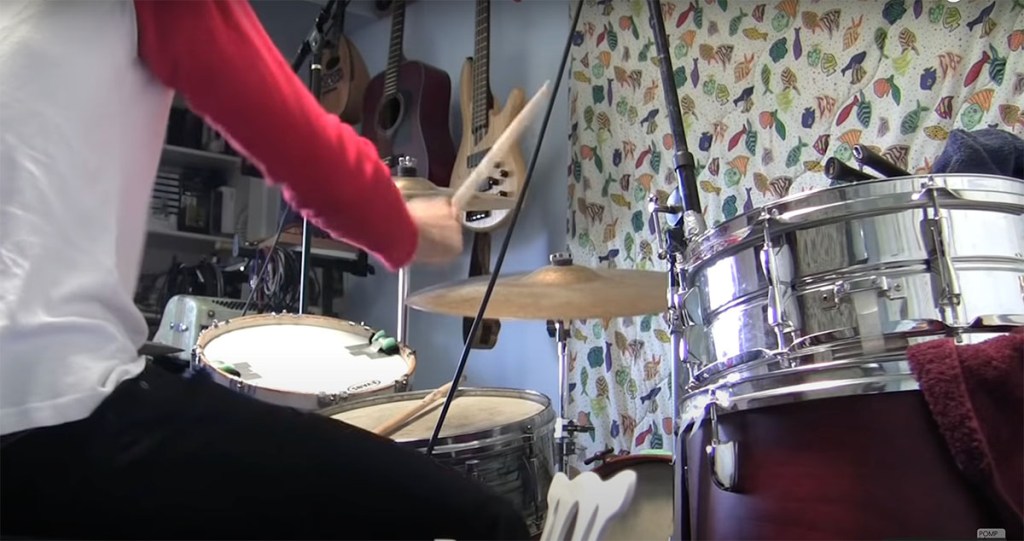
Pomplamoose’s Jack Conte has a rule for making music videos: “If at some point you hear something, you must see it.”
Chapter 5: We start recording
How do you create an honest music video? Show everything — even if you’re sweating.
NATALY DAWN: We were recording in Jack’s childhood bedroom.
JACK CONTE: We couldn’t afford audio foam. So we just took the blankets from my bed.
NATALY DAWN: — with fish patterns and octopuses.
JACK CONTE: — and hung them on the walls. Real expert recording technology right there. I had a little Mbox. So you could plug in a microphone, and then it could record onto your computer. And this was just incredible. This was mind blowing technology.
NATALY DAWN: We’re recording everything onto video tapes. We would do several takes of piano.
JACK CONTE: And when we got a take that we liked —
NATALY DAWN: He would go, “Okay, that last take was the right take.”
JACK CONTE: And so we would decide in the studio, “Let’s green that.” We had a little green envelope. We’d hold it in front of the camera, and we’d press record. That was Nataly’s cue when she was reviewing the footage that the thing that happened just before that one second of a green envelope was the good take. And the reason we do that is because we’re prioritizing: How do we make the best sounding song?
NATALY DAWN: Jack would be in charge of filling out any additional production.
JACK CONTE: Post processing, do all the pedals and effects and mixing and engineering.
NATALY DAWN: And during that time in the room next to his, I would be editing the video.
JACK CONTE: Which is this very manual synchronization process where you go frame by frame. Here’s where the snare hit. Okay, let’s move it one frame this way. No, that’s too early. Okay. Let’s move it one frame back. And then you find the sweet spot. This is what the best sounding song looked like. And it doesn’t always look like the best looking video. I’m sweating and it’s like, you know, grimy and not romantic and not how people think of music making. And sometimes not interesting. It’s just honest.
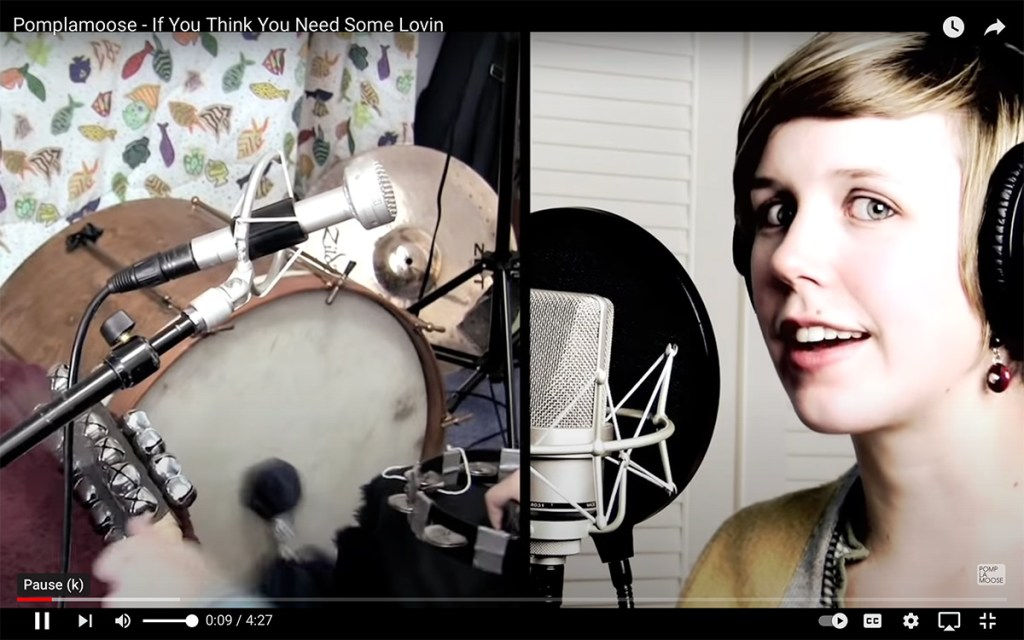
Screengrab from the Pomplamoose video “If You Think You Need Some Lovin,” showing the fish-patterned blanket used for soundproofing Jack Conte’s childhood bedroom.
Chapter 6: A cover song goes viral
How do you reach a wider audience? Adapt your work to follow the algorithm.
NATALY DAWN: If you looked for the Beatles on YouTube, the first person who would come up was Julia Nunes, not the Beatles. She was doing these really great ukulele covers. And we realized, oh, YouTube is a search algorithm. The only way they’re going to find out about our original music is if we do covers of popular songs that they’re searching for.
JACK CONTE: What if people typed in Beyonce’s “Single Ladies,” and Pomplamoose was the number one result. A lot of people would find our stuff. We should cover “Single Ladies,” and we should cover it when there’s going to be a lot of people typing it in. We knew the VMAs were coming up, and we knew the “Single Ladies” music video was incredible. And we thought it was going to win.
NATALY DAWN: Jack and me sitting together. I’m on bass. Jack is playing the piano or guitar. We’ll pick our favorite couple parts, keep those, and throw everything else out. And we kept …
JACK CONTE: The lyrics. The melody and the lyrics.
NATALY DAWN: The melody and the lyrics. And put in our own take, our own flavor on this song.
JACK CONTE: Yeah. Everything else is completely different. The sounds, the style, the genre, the chords, it’s all completely different. Taylor won best video. Not Beyonce. Kanye got up, stole the microphone out of Taylor Swift’s hand. And he said, “Taylor, sorry, but Beyonce had one of the greatest videos of all time.” Stealing her thunder and just, ugh, what an awkward moment. It was like the biggest thing that everybody was talking about.
NATALY DAWN: And you felt rushed to put it out right when that happened.
JACK CONTE: Exactly.
NATALY DAWN: And I was like, “Wait, wait, wait, wait, you have to color correct it. I look awful.”
JACK CONTE: And I was like, “Nope, it’s going up right now.” Everyone went online the next day and searched “Beyonce Single Ladies,” and Pomplamoose’s video popped up and we got half a million views overnight. And the video went totally viral.
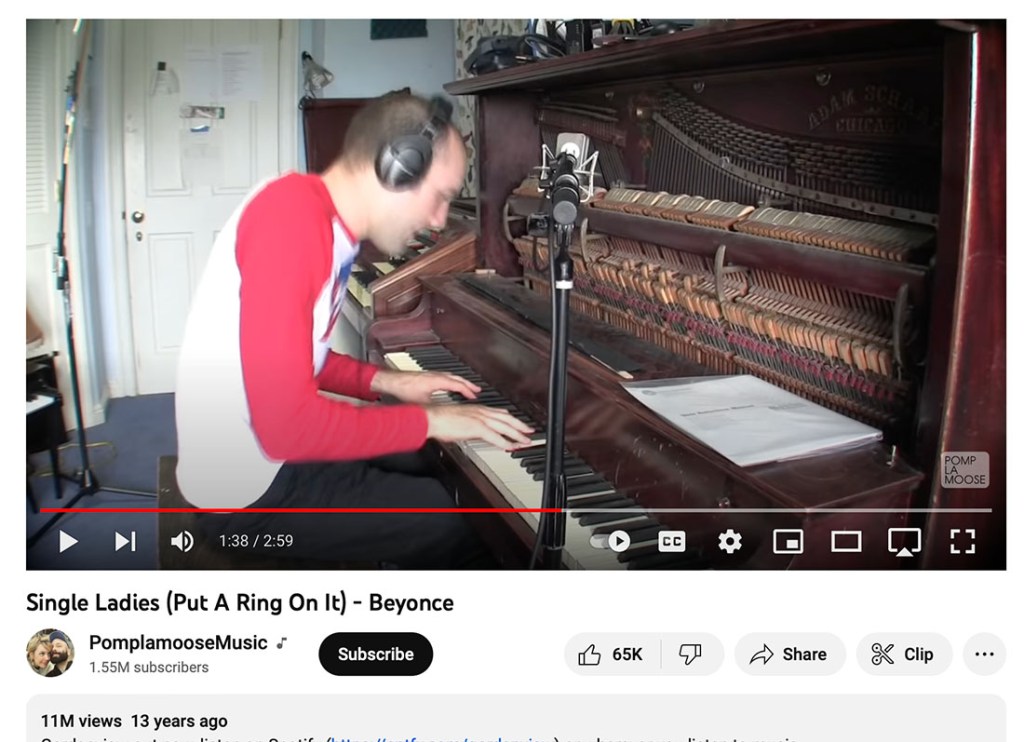
When Pomplamoose posted their cover of “Single Ladies (Put a Ring on It)” by Beyoncé, they immediately went viral. Even though Jack Conte thinks he looks like Animal from the Muppets.
Chapter 7: How dare you
JACK CONTE: It was incredibly divisive. It was not universally loved. I remember our like ratio on YouTube, and most people liked it, but there was a good 10% that was laying on the hatred.
“How dare you cover this incredible song? You guys sound terrible, and you’ve ruined this song.” And there were people who eviscerated us. I think it broke people’s paradigm for what music making ought to be. They’re used to seeing a singer who’s vibing with the camera and shaking their finger and shaking their booty and wearing a sparkling dress. And that’s not how we make music. Nataly is very focused and calm when she sings, which is just how she sings.
And I’m playing keyboards like Animal from the Muppets. And it looks ridiculous. We also took the genre of the song and converted into this low-fi, low key, indie pop thing. And it was this bouncy hip hop badass song before. And it was very hurtful for me and still is, I’d like to say, “oh, I’ve, I’ve figured out how to be resilient and have thick skin and blah, blah, blah.” And that’s not the truth. The truth is it still hurts. And yet I want to have impact. And I want to say things, and I want to reach people. But that was probably one of the early moments of that lesson to me, which is, keep going, just keep saying what you have to say, keep doing what you have to do and you’ll reach people. And there will be people who don’t like it as well. And you know, you could be okay with that as you can be.
Chapter 8: The best night of my life
JACK CONTE: About a week before posting “Single Ladies,” we had booked a show at a local laundromat, it’s called Brainwash Cafe. The idea was you can come do your laundry, have some food, by the time you’re done pick up your laundry and go. It held max 40 people. We booked a show, posted “Single Ladies,” “Single Ladies” exploded. And a week later when we showed up to play the show, there were like 200 people crammed inside Brainwash Cafe and probably another 150 to 200, not even able to see the show standing outside in the cold, not hearing it, just trying to get a glimpse.
NATALY DAWN: This place was packed. There was no stage. So I was singing, and there was someone who was a foot away from my face. And a couple times they accidentally hit the mic, and the mic went into my face, and they were just so apologetic, but it was the most beautifully awkward moment.
JACK CONTE: And it was the moment when we realized: this is going to work. After years of playing empty bars. There’s a path forward here where we can be artists. Which God, even thinking about that, I’m literally getting emotional, just saying that for. It felt like the best night of my life.
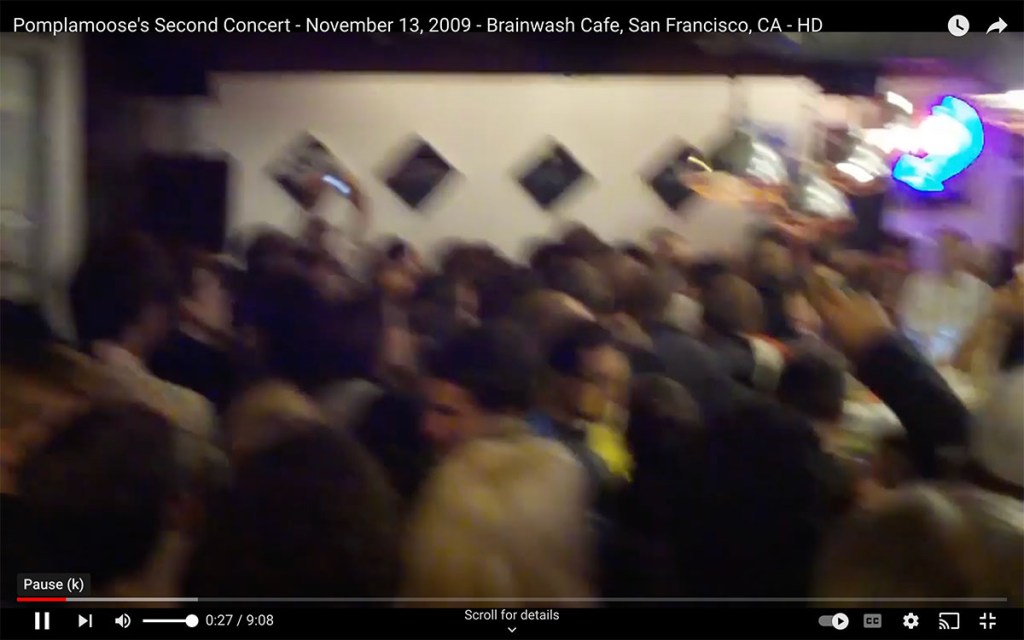
“If you can’t see me, my name is Jack.” At an incredibly crowded Brainwash Cafe in 2009, Jack Conte and Nataly Dawn realize their band had the potential to be big.
Chapter 9: We need a break
How do you keep creating in a dark and complicated time? Hold true to what you love — and adapt.
JACK CONTE: I was one of those kids in my 20s who swore that I’d never grow up to be a businessman in my 30s. I was like, I am not going to be that kind of artist. I’m going to be the artist that stays an artist. And then I started a tech company by accident. I launched Patreon and suddenly had a triple-time job.
NATALY DAWN: At that time both of us had sick parents.
JACK CONTE: That’s right. I forgot about that. Simultaneous musical joy, everything we’d ever dreamed of, and then personal life, total crash and horror. So we took a break.
NATALY DAWN: I had focused on my first solo release, How I Knew Her. I had signed to Nonesuch, which is a label subsidiary of Warner. I was going on tour. I remember missing making things together and feeling like it was kind of a tragedy that we’d stopped Pomplamoose. That Pomplamoose was going really well, but that there was so much other stuff happening in our lives and that we were so overwhelmed. And honestly it was a low point for our relationship. We were having … It was a really dark and complicated time for us.
JACK CONTE: We didn’t want to quit Pomplamoose. We loved Pomplamoose, and we loved the music that we made together and what it sounded like. And we loved the process of making things together. It’s a total joy to be with Nataly in the studio. She’s my favorite creative collaborative partner I’ve ever worked with in my life. And I didn’t want to give that up. And I just was like, I’m not going to stop making art. I cannot stop making art.
NATALY DAWN: We’re going to do this and we’re going to get better at communicating our needs. And we’re going to be more thoughtful about it this time. There was something very healing about that.
JACK CONTE: So we decided to work on a new record.
Chapter 10: Pomplamoose returns — for Season 2
How do you come back after a hiatus? Adapt to the new world, and abandon your old rules.
NATALY DAWN: The weird thing that happens when you stop posting videos is that your audience stops checking in to watch your videos. And so the fact that Pomplamoose had taken a break meant that our fan base was less engaged, and we were trying to figure out, okay, how do we get back into this? How do we get people watching our videos again? Because during that time the internet had changed.
JACK CONTE: It felt a little bit like coming back to the Coho 10 years later, and they had changed the carpet, and there was a different type of beer. And the kitchen staff was different. The food tasted different. That’s what it felt like coming back to YouTube. It was like, oh, this place has changed a little bit.
NATALY DAWN: And it wasn’t that special anymore to see someone playing what they were singing. Everybody was doing it. We knew that we needed to iterate.
JACK CONTE: What we wanted to do was do something completely different. We called it Pomplamoose Season Two. The whole idea of Pomplamoose Season Two was that it was Season Two. This is us trying something new and abandoning the rules that we had held so sacred for the first chapter. We upped the creativity. We upped the production value. We upped the conceptualization of it.
We wanted to shake it up. So it was deliberately not a video song. It was more like a music video.
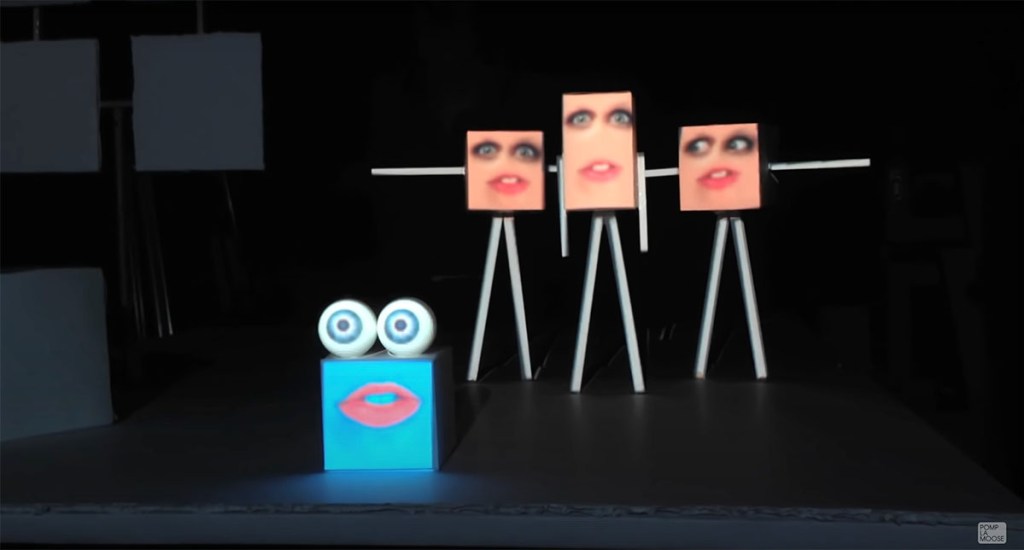
A screengrab from the first music video made by “Pomplamoose Season 2.” Read on to learn more.
Chapter 11: We discover the mashup
How do you know when your adaptation is working? It fits together — like a jigsaw puzzle.
NATALY DAWN: I understand why people love mashups. It is like an audio magic trick because you recognize all of the various elements of a song, and you get to sort of break them apart. You get to decompose the song and put all the puzzle pieces back together in a different way.
JACK CONTE: Something lights up in my brain when I hear 2 things from different moments of my life or different areas of culture that are completely disparate, but happening at the same time in concert, and it works. It just fills us with all these conflicting, odd, new combinations of emotions and stories. And I think great mashups execute on that really well. It’s like watching a round peg go into a round hole. It should be. It’s just like that was meant to be.
There’s one phrase that happens at the beginning of a bar from a Daft Punk song, “Lose yourself to dance.” And here’s where that comes in the bar. One, two, “lose yourself to dance.” So it happens on three and four, but then there’s this other song that Pharrell has called, “Happy.” Where the hook happens on one and two, “Because I’m happy, clap along if you feel like a room without a roof.”
NATALY DAWN: “Lose yourself to dance.”
JACK CONTE: “Clap along. If you feel like happiness is the truth.”
NATALY DAWN: “Lose yourself to dance.”
JACK CONTE: “Clap along if…” Right? So it’s like a jigsaw puzzle, like they were meant to be together and it’s just like, we have to put these things together. They fit together. We must do this.
Chapter 12: Making the video for “Happy Get Lucky”
JACK CONTE: We had four days to make the music video, start to finish: a Thursday, a Friday, a Saturday, and a Sunday. Thursday, I would start working on the brainstorming for the video. What I would do is like pace and walk around all day, and then write down ideas. So here’s the cube that has 3 Nataly’s projected onto it. Here’s the box monster who’s singing the song with the lips and the eyeballs that were Nataly’s. We started planning out what it would be like to project video onto both Nataly and onto a foam set with Nataly singing live and set-swapping live as well.Friday: Nataly and I go start building all of this. So we go to JoAnn’s, we buy the fabrics, we buy the foam, we buy the wood, we start cutting the shapes that we need out of foam to construct the set.By Saturday, we’ve basically finished the set. And at that point we start filming video and dragging the video into Final Cut Pro. That allows us to start projecting onto the foam and the white set. And then Sunday evening, we shoot the whole video in 1 take, start to finish. And Nataly was wearing this awesome white corset. And we projected this face onto her torso, which was just so strange and interesting and fun. And then we posted it.
Chapter 13: Something has to change
NATALY DAWN: So at a point in your career, when you have way less time to dedicate to music videos, we were like, let’s spend way more time on music videos.
JACK CONTE: We were working really long days. I mean, we just didn’t stop working. We barely slept.
NATALY DAWN: You were working on a start-up, and there are no extra hours when you are starting a company.
JACK CONTE: I was working at Patreon from 8:00 AM until 10:00 PM. And then Pomplamoose was to try and film the video 11:00 PM to 3:00 AM, 4:00 AM. I mean, we were grinding.
NATALY DAWN: We did the Season Two tour just like night after night after night of shows. And the whole day in the van, you were on your laptop and taking calls and running Patreon. And it was just so much; it was too much.
JACK CONTE: It was too much.
NATALY DAWN: And so we were really like.
JACK CONTE: That’s not working.
NATALY DAWN: It was not working.
JACK CONTE: It’s not that it wasn’t working because it wasn’t reaching people, it was. We were reaching people. It wasn’t working because we couldn’t keep doing that. We didn’t have the time.
NATALY DAWN: It’s exhausting.
JACK CONTE: Yeah. I’m not going to be able to do Patreon and continue to do Pomplamoose like we’ve been doing Pomplamoose. Something is going to have to change.
Chapter 14: Pomplamoose, Phase 3
JACK CONTE: It starts with a problem. The video song started with a constraint. I’m making music, but the audience is on the video platform. And the problem this time was I am a full-time operator and don’t have hours to make music.
NATALY DAWN: This to me feels like the first time where we’ve been able to really hone in on what the problem is so that we don’t get overwhelmed. And so that we don’t stop making music together.
JACK CONTE: The thought was: is there any way that we can make music in just one day a month?If I went down to LA with Nataly, and we took a Saturday and recorded four songs, and then instead of editing the snare drum and editing the video and editing and doing all this stuff ourselves, what if we built a team?
NATALY DAWN: In 2018, we started recording 4 songs in a day and releasing a song and video every week.
JACK CONTE: We just basically do the arrangement and recording, and then a team does the rest.
NATALY DAWN: We had other musicians and a camera crew. We hired our head of ops. Then we brought on a full-time head of audio. And then we also brought on a head of video.
JACK CONTE: 4 years into that endeavor, Pomplamoose actually has 5 full-time teammates. And we work with maybe 15 or 20 contractors. And it turns out that it worked.
NATALY DAWN: It actually has achieved what we wanted, which is that we’re able to have this creative project with each other that we love without either of us carrying too much of the weight from it.You’re able to spend most of your time on Patreon. I’m able to spend more of my time doing songwriting and working on solo projects. And so this feels like a real turning point for the band and such a joyful turning point. This beautiful opening up for our music and for us because we have a community now because we have a team, which took so long to figure out.
How my band @PomplamooseMusic records 5 songs in a day
Chapter 15: It’s a new thing now
How do you build an adaptable creative team? Find collaborators who light up when things change course.
JACK CONTE: Suddenly Nataly and I are in a recording studio with 5 musicians and a camera crew and a recording engineer and a director of photography and a team of post production folks who are helping us edit videos. We went in to do the song “Sweet Dreams.” And when we were trying to re-harm “Sweet Dreams” and come up with chords and come up with a melody, Ben Rose, who’s our drummer.
NATALY DAWN: And producer.
JACK CONTE: And producer. Had this wide eyed grin and excitement and pointed at us and said, “You should do the song. What’s the song?” And then Nataly can sing on top of that. So it felt like this ding moment to us in the studio.
NATALY DAWN: That was caught on film. So what you’re seeing at the beginning of that video was a true moment of an idea. Sarah and I had been rehearsing our vocal parts. We got to a good place, came back into the studio, and you were like, “It’s a mash up now.” And I remember us both looking at each other in a state of panic and just being like, “Okay, here we go.” It’s a new thing now. We completely changed the course of what we’d been planning. The musicians are so good that they just adapt, and they switch modes, and they just go.
Chapter 16: What is Pomplamoose anyway?
JACK CONTE: Pomplamoose is why you get your drums out of the attic after 15 years and start playing again.
NATALY DAWN: Pomplamoose is community and pure joy.
JACK CONTE: Pomplamoose is a venue for co-creation between people who love each other and have a good time. It started as me and Nataly. Now it’s this much broader, wonderful, creative, fun team. And we get to make things together, and fuck if that’s not living the dream. Creating things with people you love is the greatest magic that happens on Earth.
NATALY DAWN: I get to come into a room and be with these people and be creative with them. It’s kind of like, autotelic. The value is not in what you will achieve by doing this thing. It’s just that you get to do this thing.
JACK CONTE: And it’s always changing and adapting. Once it was a band, and now it’s more like a media company, and 5 years from now, who knows what it’ll be.
JUNE COHEN: I want to thank Nataly and Jack for sharing the story of their creative journey. I hope you found things in it that you can bring into your own work.
Maybe it’s the way they continually adapt their creative life to match their personal life, always asking themselves: what are we solving for? Maybe it’s the way Nataly and Jack continually adapt their formats — from video songs to cover songs to mashups and beyond, creating and iterating as the culture changes around them. Or maybe it’s the way they adapt Pomplamoose over time — from bedroom recordings to an entire production company — allowing them to keep doing the work they love.

